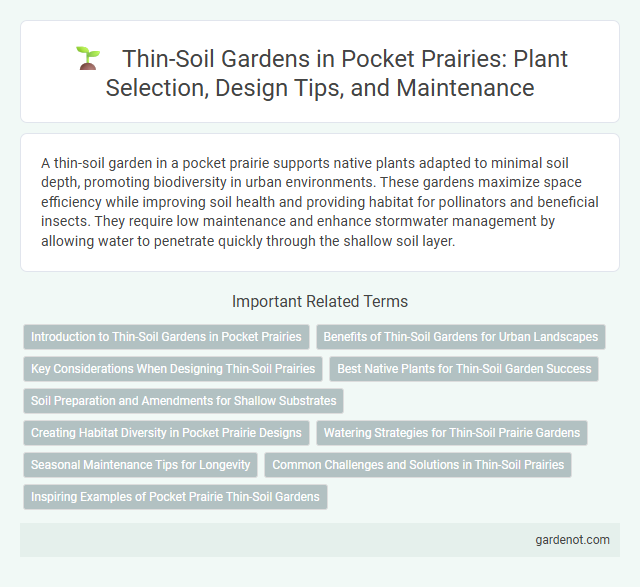A thin-soil garden in a pocket prairie supports native plants adapted to minimal soil depth, promoting biodiversity in urban environments. These gardens maximize space efficiency while improving soil health and providing habitat for pollinators and beneficial insects. They require low maintenance and enhance stormwater management by allowing water to penetrate quickly through the shallow soil layer.
Introduction to Thin-Soil Gardens in Pocket Prairies
Thin-soil gardens thrive in shallow, nutrient-poor soils, replicating natural prairie conditions with minimal soil depth. They support native plants like prairie grasses and wildflowers adapted to low soil fertility, promoting biodiversity and pollinator habitats in urban pocket prairies. These gardens require less maintenance, drought tolerance, and contribute to sustainable green spaces by enhancing soil health and ecosystem resilience.
Benefits of Thin-Soil Gardens for Urban Landscapes
Thin-soil gardens transform urban landscapes by promoting native plant growth in shallow soil layers, enhancing biodiversity and supporting pollinators such as bees and butterflies. These gardens improve stormwater management by allowing better infiltration and reducing runoff, which helps mitigate urban flooding and water pollution. Their low-maintenance nature and resilience in harsh urban conditions make them ideal for sustainable green infrastructure in cities.
Key Considerations When Designing Thin-Soil Prairies
Designing thin-soil prairies requires careful evaluation of soil depth, drainage, and native plant species adapted to low-nutrient conditions. Selecting drought-tolerant grasses and wildflowers enhances resilience in shallow, well-drained soils often found in urban pocket prairies. Monitoring soil erosion and periodic maintenance ensures long-term sustainability and biodiversity within thin-soil garden environments.
Best Native Plants for Thin-Soil Garden Success
Thin-soil gardens thrive with native plants such as Prairie Dropseed (Sporobolus heterolepis), Little Bluestem (Schizachyrium scoparium), and Purple Coneflower (Echinacea purpurea) that adapt well to nutrient-poor, shallow soils. These drought-tolerant species promote biodiversity, requiring minimal maintenance while supporting pollinators like bees and butterflies. Incorporating native grasses and wildflowers ensures soil stabilization and ecological resilience in pocket prairie landscapes.
Soil Preparation and Amendments for Shallow Substrates
Thin-soil gardens require careful soil preparation to maximize nutrient availability in shallow substrates, often less than 6 inches deep. Incorporating organic amendments such as compost or well-aged manure improves soil structure, moisture retention, and microbial activity essential for plant health. Selecting drought-tolerant, native plant species further enhances the garden's resilience and ecological function in limited soil conditions.
Creating Habitat Diversity in Pocket Prairie Designs
Thin-soil gardens in pocket prairie designs enhance habitat diversity by supporting specialized plant species adapted to shallow, nutrient-poor soils, which in turn attract diverse pollinators and ground-nesting insects. Incorporating native grasses and wildflowers in thin-soil areas fosters microhabitats, promoting ecological resilience and increasing biodiversity. These gardens optimize limited soil resources, creating layered habitats that support amphibians, small mammals, and beneficial insects, critical for sustainable urban ecosystems.
Watering Strategies for Thin-Soil Prairie Gardens
Thin-soil prairie gardens require precise watering strategies to maintain plant health while preventing waterlogging. Implementing targeted drip irrigation and scheduling watering during early mornings helps conserve moisture and supports deep root growth. Mulching around native prairie plants further retains soil moisture and reduces evaporation in these shallow soil conditions.
Seasonal Maintenance Tips for Longevity
Thin-soil gardens in pocket prairies thrive with seasonal maintenance practices that enhance soil health and plant survival. Regularly removing invasive species, mulching with organic matter, and monitoring moisture levels prevent soil erosion and nutrient depletion. Implementing periodic pruning and seasonal fertilization supports native plant resilience and extends the garden's longevity.
Common Challenges and Solutions in Thin-Soil Prairies
Thin-soil prairies often face challenges such as poor nutrient availability, limited water retention, and difficulty establishing deep-rooted native plants. Solutions include selecting drought-tolerant native species adapted to shallow soils, implementing mulch layers to conserve moisture, and incorporating organic matter to improve soil fertility and structure. Regular monitoring and adaptive management support long-term prairie resilience and biodiversity in these challenging soil conditions.
Inspiring Examples of Pocket Prairie Thin-Soil Gardens
Pocket prairie thin-soil gardens showcase innovative use of shallow, nutrient-poor soils to cultivate native prairie plants, demonstrating resilience and biodiversity in urban settings. These gardens feature species like little bluestem, prairie dropseed, and wild bergamot, which thrive in minimal soil depth, promoting pollinator habitats and reducing maintenance. Inspiring examples include rooftop installations and compact urban plots that maximize ecological benefits while enhancing aesthetic value in limited spaces.
Thin-soil garden Infographic

 gardenot.com
gardenot.com